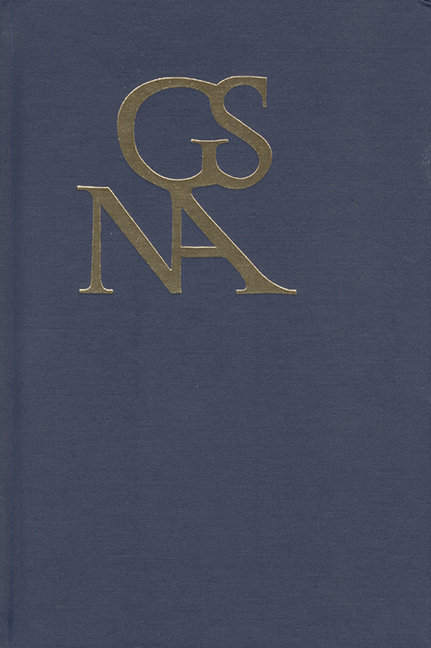Book contents
- Frontmatter
- Contents
- Special Section on What Goethe Heard, edited by Mary Helen Dupree
- What Goethe Heard: Special Section on Hearing and Listening in the Long Eighteenth Century
- Behind Herder's Tympanum: Sound and Physiological Aesthetics, 1800/1900
- Becoming the Listener: Goethe's “Der Fischer”
- Of Barks and Bird Song: Listening in on the Forgotten in Ludwig Tieck's Der blonde Eckbert
- Garden Empire or the Sublime Politics of the Chinese-Gothic Style
- Die Austreibung des Populären: Schillers Bürger-Kritik
- Goethe and the Uncontrollable Business of Appropriative Stage Sequels
- Repetition and Textual Transmission: The Gothic Motif in Goethe's Faust and “Von deutscher Baukunst”
- “Die gewalt'ge Heldenbrust”: Gender and Violence in Goethe's Iphigenie auf Tauris
- Literary Form and International World Order in Goethe: From Iphigenie to Pandora
- Two Gifts from Goethe: Charlotte von Stein's and Charlotte Schiller's Writing Tables
- Goethe's Wilhelm Meister and the Refusal to Grow Up: The Dialectics of Bildung
- “So steh' ich denn hier wehrlos gegen dich?”— Figures of Armament and Disarmament in German Drama before and after the French Revolution
- Goethe, Maimon, and Spinoza's Third Kind of Cognition
- Die Neuvermessung von Lyrik und Prosa in Goethes Novelle
- Book Reviews
Two Gifts from Goethe: Charlotte von Stein's and Charlotte Schiller's Writing Tables
from Special Section on What Goethe Heard, edited by Mary Helen Dupree
Published online by Cambridge University Press: 16 May 2018
- Frontmatter
- Contents
- Special Section on What Goethe Heard, edited by Mary Helen Dupree
- What Goethe Heard: Special Section on Hearing and Listening in the Long Eighteenth Century
- Behind Herder's Tympanum: Sound and Physiological Aesthetics, 1800/1900
- Becoming the Listener: Goethe's “Der Fischer”
- Of Barks and Bird Song: Listening in on the Forgotten in Ludwig Tieck's Der blonde Eckbert
- Garden Empire or the Sublime Politics of the Chinese-Gothic Style
- Die Austreibung des Populären: Schillers Bürger-Kritik
- Goethe and the Uncontrollable Business of Appropriative Stage Sequels
- Repetition and Textual Transmission: The Gothic Motif in Goethe's Faust and “Von deutscher Baukunst”
- “Die gewalt'ge Heldenbrust”: Gender and Violence in Goethe's Iphigenie auf Tauris
- Literary Form and International World Order in Goethe: From Iphigenie to Pandora
- Two Gifts from Goethe: Charlotte von Stein's and Charlotte Schiller's Writing Tables
- Goethe's Wilhelm Meister and the Refusal to Grow Up: The Dialectics of Bildung
- “So steh' ich denn hier wehrlos gegen dich?”— Figures of Armament and Disarmament in German Drama before and after the French Revolution
- Goethe, Maimon, and Spinoza's Third Kind of Cognition
- Die Neuvermessung von Lyrik und Prosa in Goethes Novelle
- Book Reviews
Summary
IT IS WELL KNOWN that before and after his transformative journey to Italy (1786–88), Goethe enjoyed two intense, decade-long friendships: with Charlotte von Stein in the decade before Italy, and with Charlotte Schiller from 1794 until the latter's death in 1805. What is less known, even now, is that both Charlotte von Stein and Charlotte Schiller were writers in their own right. In 1779 and 1794, Goethe gave the gift of a desk or “writing-table” (Schreibtisch) to Charlotte von Stein and Charlotte Schiller, respectively. In what follows, I explore the histories of these two gifts and the associated acts of gift-giving as staged by Goethe in these two phases of his life. As pieces of furniture used for the purpose of writing, and as gifts from a male writer to women who also wrote, the two desks suggest a range of meanings for both the giver and the two Charlottes who were the recipients. Social theorists have long argued that gifts are never “free,” but always figure in a complex system of social relationships founded upon mutual expectation and obligation. As we shall see, Goethe's gifts are good examples of that.
Charlotte von Stein (1742–1827) was a lady of the court of Saxe-Weimar- Eisenach, serving chiefly as a companion to Duchess Luise, the wife of Goethe's patron Duke Karl August, and to his mother the Dowager Duchess Anna Amalia. She had been married since 1764 to Karl August's master of stables, Josias von Stein, and had borne seven children, of whom only three had survived infancy. Soon after Goethe's arrival in Weimar in 1776, she became the object of his intense desire. Of the thousands of letters and notes they exchanged, only Goethe's (about 1600) have survived. Those letters document an intimate though most likely platonic relationship, as well as a fully shared social and intellectual life. Stein introduced him to the intricacies of aristocratic court life, and Goethe introduced her to his many literary and scientific pursuits, for which her education and reading made her the ideal dialogue partner. Their relationship was interrupted when Goethe abruptly departed for Italy in 1786, and it eventually broke off when, after his return in 1788, he entered a common-law relationship with Christiane Vulpius, a young woman of lower social status.
- Type
- Chapter
- Information
- Goethe Yearbook 25Publications of the Goethe Society of North America, pp. 203 - 216Publisher: Boydell & BrewerPrint publication year: 2018



